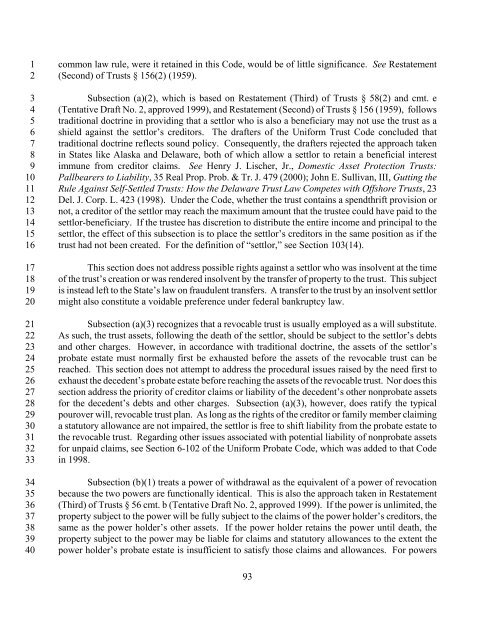uniform trust code - Kansas Judicial Branch
uniform trust code - Kansas Judicial Branch
uniform trust code - Kansas Judicial Branch
You also want an ePaper? Increase the reach of your titles
YUMPU automatically turns print PDFs into web optimized ePapers that Google loves.
1<br />
2<br />
3<br />
4<br />
5<br />
6<br />
7<br />
8<br />
9<br />
10<br />
11<br />
12<br />
13<br />
14<br />
15<br />
16<br />
17<br />
18<br />
19<br />
20<br />
21<br />
22<br />
23<br />
24<br />
25<br />
26<br />
27<br />
28<br />
29<br />
30<br />
31<br />
32<br />
33<br />
34<br />
35<br />
36<br />
37<br />
38<br />
39<br />
40<br />
common law rule, were it retained in this Code, would be of little significance. See Restatement<br />
(Second) of Trusts § 156(2) (1959).<br />
Subsection (a)(2), which is based on Restatement (Third) of Trusts § 58(2) and cmt. e<br />
(Tentative Draft No. 2, approved 1999), and Restatement (Second) of Trusts § 156 (1959), follows<br />
traditional doctrine in providing that a settlor who is also a beneficiary may not use the <strong>trust</strong> as a<br />
shield against the settlor’s creditors. The drafters of the Uniform Trust Code concluded that<br />
traditional doctrine reflects sound policy. Consequently, the drafters rejected the approach taken<br />
in States like Alaska and Delaware, both of which allow a settlor to retain a beneficial interest<br />
immune from creditor claims. See Henry J. Lischer, Jr., Domestic Asset Protection Trusts:<br />
Pallbearers to Liability, 35 Real Prop. Prob. & Tr. J. 479 (2000); John E. Sullivan, III, Gutting the<br />
Rule Against Self-Settled Trusts: How the Delaware Trust Law Competes with Offshore Trusts, 23<br />
Del. J. Corp. L. 423 (1998). Under the Code, whether the <strong>trust</strong> contains a spendthrift provision or<br />
not, a creditor of the settlor may reach the maximum amount that the <strong>trust</strong>ee could have paid to the<br />
settlor-beneficiary. If the <strong>trust</strong>ee has discretion to distribute the entire income and principal to the<br />
settlor, the effect of this subsection is to place the settlor’s creditors in the same position as if the<br />
<strong>trust</strong> had not been created. For the definition of “settlor,” see Section 103(14).<br />
This section does not address possible rights against a settlor who was insolvent at the time<br />
of the <strong>trust</strong>’s creation or was rendered insolvent by the transfer of property to the <strong>trust</strong>. This subject<br />
is instead left to the State’s law on fraudulent transfers. A transfer to the <strong>trust</strong> by an insolvent settlor<br />
might also constitute a voidable preference under federal bankruptcy law.<br />
Subsection (a)(3) recognizes that a revocable <strong>trust</strong> is usually employed as a will substitute.<br />
As such, the <strong>trust</strong> assets, following the death of the settlor, should be subject to the settlor’s debts<br />
and other charges. However, in accordance with traditional doctrine, the assets of the settlor’s<br />
probate estate must normally first be exhausted before the assets of the revocable <strong>trust</strong> can be<br />
reached. This section does not attempt to address the procedural issues raised by the need first to<br />
exhaust the decedent’s probate estate before reaching the assets of the revocable <strong>trust</strong>. Nor does this<br />
section address the priority of creditor claims or liability of the decedent’s other nonprobate assets<br />
for the decedent’s debts and other charges. Subsection (a)(3), however, does ratify the typical<br />
pourover will, revocable <strong>trust</strong> plan. As long as the rights of the creditor or family member claiming<br />
a statutory allowance are not impaired, the settlor is free to shift liability from the probate estate to<br />
the revocable <strong>trust</strong>. Regarding other issues associated with potential liability of nonprobate assets<br />
for unpaid claims, see Section 6-102 of the Uniform Probate Code, which was added to that Code<br />
in 1998.<br />
Subsection (b)(1) treats a power of withdrawal as the equivalent of a power of revocation<br />
because the two powers are functionally identical. This is also the approach taken in Restatement<br />
(Third) of Trusts § 56 cmt. b (Tentative Draft No. 2, approved 1999). If the power is unlimited, the<br />
property subject to the power will be fully subject to the claims of the power holder’s creditors, the<br />
same as the power holder’s other assets. If the power holder retains the power until death, the<br />
property subject to the power may be liable for claims and statutory allowances to the extent the<br />
power holder’s probate estate is insufficient to satisfy those claims and allowances. For powers<br />
93

















